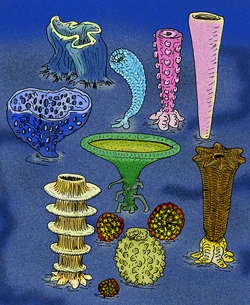| Archaeocyatha Fossil range: Early - Late Cambrian | |
|---|---|
 | |
| Scientific classification
| |
|
Parazoa | |
|
Porifera? (sponges) | |
|
Archaeocyatha | |
| |

1 – Gap (intervallum)
2 – Central cavity
3 – Internal wall
4 – Pore (all the walls and septa have pores, not all are represented)
5 – Septum
6 – External wall
7 – Rizoid
The Archaeocyatha or archaeocyathids ("ancient cups") were sessile, reef-building[1] marine organisms of warm tropical and subtropical waters that lived during the early (lower) Cambrian period. They are first known from the beginning of the Tommotian Age of the Cambrian, about 530 million years ago (mya), and quickly diversified into over a hundred families. They became the planet's very first reef building animals.
Today, the archaeocyathan families are recognizable by small but consistent differences in their fossilized structures: Some archaeocyathans were built like nested bowls, while others were as long as 30 cm. Some archaeocyaths were solitary organisms, while others formed colonies. Then, around 520 mya, the archaeocyaths went into a sharp decline. Almost all species became extinct by the Middle Cambrian, with the final-known species disappearing just prior to the end of the Cambrian period, Antarcticocyathus webberi.[2] Their rapid decline and disappearance coincided with a rapid diversification of the Demosponges.
The typical archaeocyathd resembled a hollow horn coral. Each had a conical or vase-shaped porous skeleton of calcite similar to that of a sponge. The structure appeared like a pair of perforated, nested ice cream cones. Their skeletons consisted of either a single porous wall (Monocyathida), or more commonly as two concentric porous walls, an inner and outer wall separated by a space. Inside the inner wall was a cavity (like the inside of an empty ice cream cone). At the base, these pleosponges were held to substrate with holdfast. The body presumably occupied the space between the inner and outer shells (the intervallum). Flow tank experiments suggest that archaeocyathan morphology allowed them to exploit flow gradients, either by passively pumping water through the skeleton, or, as in present-day, extant sponges, by drawing water through the pores, removing nutrients, and expelling spent water and wastes through the pores into the central space.
The archaeocyathans inhabited coastal areas of shallow seas. Their widespread distribution over almost the entire Cambrian world, as well as the taxonomic diversity of the species, might be explained by surmising that that they were planktonic during their larval stage.
Their phylogenetic affiliation has been subject to changing interpretations: Yet the consensus is growing that the archaeocyath was indeed a kind of sponge,[3] thus sometimes called a pleosponge. But some invertebrate paleontologists have placed them in an extinct, separate phylum, known appropriately as the Archaeocyatha.[4] However, one cladistic analysis[5] suggests that Archaeocyatha is a clade nested within the phylum Porifera (better known as the true sponges).
Taxonomy[]
The clade Archaeocyatha have traditionally been divided into Regulares and Irregulares (Rowland, 2001):
- Hetairacyathida (incertae sedis)
- Regulares
- Monocyathida
- Capsulocyathida
- Ajacicyathida
- Irregulares
- Thalassocyathida
- Archaeocyathida
- Kazakhstanicyathida
However, Okulitch (1955), divided the phylum in three classis:
- Phylum Archaeocyatha Vologdin, 1937
- Class Monocyathea Okulitch, 1943
- Class Archaeocyathea Okulitch, 1943
- Class Anthocyathea Okulitch, 1943
Notes[]
- ^ Archaeocyathid reef structures ("bioherms"), although not as massive as later coral reefs, might have been as deep as ten meters (Emiliani 1992:451).
- ^ The last-recorded archaeocyathan is a single species from the late (upper) Cambrian of Antarctica.
- ^ Scuba divers have discovered living calcareous sponges, including one species that -- like the archaeocyathans -- is without spicules, thus morphologically similar to the archaeocyaths. Rowland, S.M. (2001). "Archaeocyatha: A history of phylogenetic interpretation". Journal of Paleontology 75: 1065-1078. http://findarticles.com/p/articles/mi_qa3790/is_200111/ai_n8958761/pg_1?tag=artBody;col1. Retrieved on 2008-11-05.
- ^ Debrenne, F. and J. Vacelet. 1984. "Archaeocyatha: Is the sponge model consistent with their structural organization?" in Palaeontographica Americana, 54:pp358-369.
- ^ J. Reitner. 1990. "Polyphyletic origin of the 'Sphinctozoans'", in Rutzler, K. (ed.), New Perspectives in Sponge Biology: Proceedings of the Third International Conference on the Biology of Sponges (Woods Hole) pp. 33-42. Smithsonian Institution Press, Washington, DC.
References[]
- Emiliani, Cesare. (1992). Planet Earth : Cosmology, Geology, & the Evolution of Life & the Environment. Cambridge University Press. (Paperback Edition ISBN 0-521-40949-7), p 451
- Okulitch, V. J., 1955: Part E – Archaeocyatha and Porifera. Archaeocyatha, E1-E20 in Moore, R. C., (ed.) 1955: Treatise on Invertebrate Paleontology. Geological Society of America & University of Kansas Press, Lawrence, Kansas, 1955, xviii-E122.